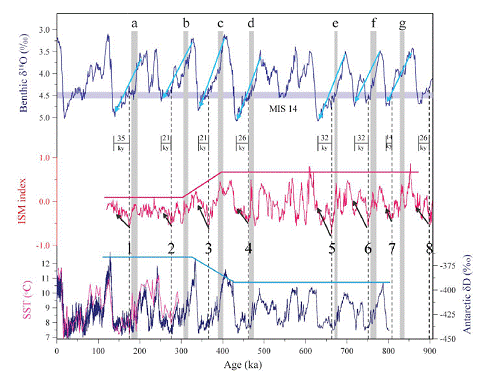The Indian summer monsoon (ISM) is one of the most important climate system on the earth, providing primary water resources for vast regions across the East Africa, South Asia and East Asia and feeding about one third of the world’s population. The ISM is also a unique bi-hemispheric system in that it is driven by cross-equatorial pressure gradient (XEPG) between northern continent and southern ocean.
The history and variability of ISM at geological timescale is at present a hot topic, with fierce debates on the role of southern hemisphere climate. The research group in Institute of Earth Environment, Chinese Academy of Sciences (IEECAS), led by An Zhisheng, in cooperation with other researchers from China, United States and Japan, have provided a long-term ISM record, which helps to better understand the glacial-interglacial ISM variability.
This monsoon proxy was extracted from a 666-meter-long sediment core from Heqing paleolake in the southwestern China, as the first drilling core of Chinese Environmental Scientific Drilling Program. It is till now the longest high-resolution continental record for ISM evolution. Through reliable dating method, the researchers were able to reconstruct the ISM patterns during the past 2.6 Ma, linked to northern hemisphere ice volumes and Antarctic temperatures and ice volume.
From the record, the interglacial ISM maxima are synchronous with the global ice volume minima (see Figure). But, one interesting finding is that, the glacial ISM reaches a minimum, but begins to increase prior to the global ice volume reaches maximum (See Figure). The ‘strange‘ behavior of early strengthening have to be explained by the southern hemisphere high-latitude cooling. In general, the intensified northern Indian Low linked to the global ice minima dominates the amplitude of XEPG and thus ISM during interglacial periods; however, in the full glacials, cold Antarctica temperature facilitates the strengthening of southern Mascarene High and then pushes the early ISM strengthening.
This new insight into ISM on the geological timescale is important for our understanding of global climate evolution in the past and also provides good background information for present and future monsoon changes under global warming.

Figure. Comparison between Heqing ISM index (red), global ice volume (blue, benthic d18O, LR04 agescale) (Lisiecki & Raymo, 2005), and Antarctic deuterium (dark blue, EDC dD, EDC3 age scale) (J. Jouzel et al., 2007) during the past 900 ky.The mid-latitude southern hemispheric SST (pink, RC11-120) (Mashiotta, Lea & Spero, 1999) varies simultaneously with Antarctictemperature. The horizontal gray bar in the benthic d 18O shows a ~4.5‰ threshold. ISM minima leadglobal ice volume maxima by 14 to 35 ky. The black dashed vertical lines show the minima of the ISM,labeled from 1 to 8. The light blue arrows show the transition from interglacial to glacial, and theblack arrows show strengthening ISM before global ice volume maxima. Secondary ISM peaks (grayshadings, “a” through “g”) occur during the slow transition from interglacials into glacials. Thicksolid red and sky-blue lines show the long-term amplitude relationship between ISM and Antarctictemperature.
Original article citation:
An, Z.et al. Glacial-interglacial Indian summer monsoon dynamics.Science333, 719-723 (2011).
 © 2015 Institute of Earth Environment,CAS
© 2015 Institute of Earth Environment,CAS Address:No. 97 Yanxiang Road, Xi'an 710061, Shaanxi, China

 Location :
Location :